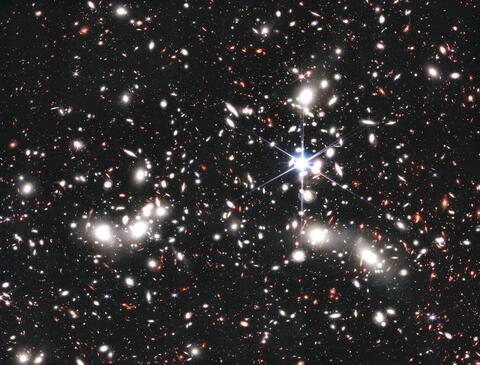The James Webb Space Telescope reveals the central role of low-mass galaxies in the reionization process of the Universe
The James Webb Space Telescope (JWST), developed by NASA and ESA, has just obtained the first spectra of very low-mass galaxies less than a billion years after the Big Bang. A technological feat made possible by the unique combination of JWST sensitivity and the gravitational lensing effect of the Abell 2744 cluster: nearby galaxies act like cosmic magnifiers, distorting space and amplifying the light of background galaxies. By demonstrating that small galaxies are very likely at the origin of the reionization of the universe, this discovery represents a major breakthrough in our knowledge of the cosmos. The international research team brought together the Universities of Pittsburgh, Swinburne and Texas in Austin in collaboration with the Paris Astrophysics Institute (Sorbonne University/CNRS). These results were published in Nature magazine on the 28 February, 2024.
-
Katherine Tyrka, international press service Sorbonne University
-
Hakim Atek, astrophysicien à Sorbonne Université, chercheur à l’Institut d’astrophysique de Paris
Reionization, which occurred some 500 to 900 million years after the Big Bang, marks a crucial period in the history of the Universe, following the recombination . It represents the transformation of neutral hydrogen, which predominated in the Universe, into ionized gas. Identifying the sources responsible for this cosmic reionization has given rise to a number of hypotheses. These include supermassive black holes containing gas accretion disks that eject high-energy radiation; large galaxies with masses in excess of one billion solar masses; and small galaxies with masses of less than 1 billion solar masses. Confirmation of the hypothesis relating to low-mass galaxies proved particularly difficult, given their low luminosity.
For the first time, an international research team involving the Paris Astrophysics Institute (Sorbonne University/CNRS) has managed to unravel the mystery by obtaining spectroscopic observations of these galaxies during the reionization period. By analyzing these very low-mass galaxies, comparable to dwarf galaxies in the local Universe, the scientists have demonstrated that small galaxies played a major role in cosmic reionization. The combination of deep observations from the JWST telescope and gravitational lensing amplification of the Abell 2744 galaxy cluster now makes it possible to determine the abundance of small galaxies and their ionizing properties during the first billion years of the Universe.
Hakim Atek, astrophysicist at Sorbonne University and researcher at the Paris Astrophysics Institute, is the first author of this study. He explains: "We found that small galaxies outnumbered massive galaxies by about a hundred to one during this epoch of reionization of the Universe. These novel observations also reveal that these small galaxies produced a considerable amount of ionizing photons, exceeding by four times the canonical values usually assumed for distant galaxies. This means that the total flux of ionizing photons emitted by these galaxies far exceeds the threshold required for reionization."
The researchers now want to extend this study to a larger scale, to confirm that this particular location is representative of the average distribution of galaxies in the Universe.
Beyond the reionization process, their observations are essential to understanding the formation of the very first galaxies, which, over 12 billion years later, would constitute our present-day galaxies.

